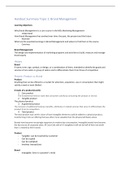College aantekeningen
Brand Managament: Summary of all Modules
- Vak
- Brand Management
- Instelling
- Tilburg University (UVT)
A summary for the course Brand Management of the Master Marketing Management at Tilburg University. Summary of all modules without the articles.
[Meer zien]




